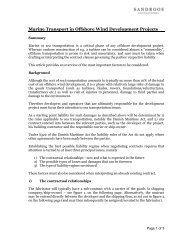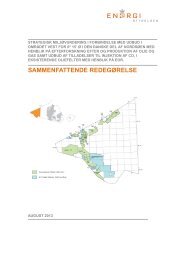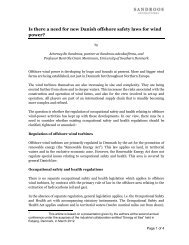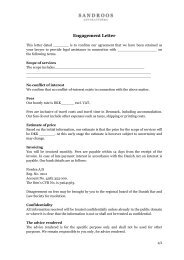The Knock-for-Knock Principle under Danish Law - Sandroos ...
The Knock-for-Knock Principle under Danish Law - Sandroos ...
The Knock-for-Knock Principle under Danish Law - Sandroos ...
You also want an ePaper? Increase the reach of your titles
YUMPU automatically turns print PDFs into web optimized ePapers that Google loves.
<strong>The</strong> <strong>Knock</strong>-<strong>for</strong>-<strong>Knock</strong><strong>Principle</strong> <strong>under</strong> <strong>Danish</strong> <strong>Law</strong>30 November 2010
<strong>The</strong> Seminar• Welcome• A few practicalities• Background of the seminar• <strong>The</strong> agenda• First part: introductory remarks• Second part: jurisdictions01/12/2010 SANDROOS 2
Physical Loss, Damage or Injury• Physical loss or damage to property• Equipment is lost• A module <strong>under</strong> construction turns over• Personal injury, illness• A broken leg, a broken back, pneumoniaAs opposed to the liability <strong>for</strong>• Defects• E.g. non-compliance with specifications, or• unskilled labour• Delay• E.g. late delivery of the module, or• late arrival of crew01/12/2010 SANDROOS 3
Rationale of Contractual Regulationof Liabilities1. Risks of offshore E&P activities• Weather conditions, working far from shore, at sea• On top of hydrocarbon accumulations – brought into industrial process• Flammable, explosive2. High number of offshore contractors• Suppliers, sub-suppliers, sub-sub-suppliers• Complex collaboration pattern, work flows• Without contractual regulation• Basis of liability – fault or statutory liability and payment of damages• Necessitates thorough and individual investigations• Can the damaging party be blamed? Strict liability?• Causality between loss and the specific circumstances?• Loss a natural and <strong>for</strong>eseeable consequence of these circumstances?• Investigations subjective• No <strong>for</strong>ecasting of potential liability, or chances of loss recovery• Risk management suffers, insurance becomes challenging01/12/2010 SANDROOS4
<strong>The</strong> Contractual Solution• Regulation of liability separated from traditional law of torts• Liability distributed to where the damage/loss occurs – who hassuffered the loss• Holds the other party harmless from claims from third parties• Irrespective of how arisen, negligence, by whome, and (principally)what the loss amounts to• An agreed channelling of liability with financing of loss viainsurance• Time-saving• Avoids litigation• Predictable• Issues to consider• Protected interests• Peoply, Property, ”Work”/”Permanent Work”• Third-party liability• Other assets/interests to be covered• Time, Geography, Exclusions, Other issues<strong>Knock</strong>-<strong>for</strong>-knockdirectsmanagementattention to thecritical path01/12/2010 SANDROOS 5
Risk ZonesOperator’s nuclear familyOperator’s extended familyContractor’s familyOperator (with affiliates)incl. management,employees and consultant +partners (co-venturers)CompanyContractors (with affiliates)incl. management,employees and consultantsFabricationInstallationSubcontractors (withaffiliates) incl.management, employeesand consultantsCompressors<strong>for</strong> processingfacilitySupplies <strong>for</strong>steel jacketAnchorhandlingvessel(Genuine) Third-parties01/12/2010 SANDROOS 6
<strong>Knock</strong>-<strong>for</strong>-<strong>Knock</strong> ComponentsCoverage anddeductibles (Contractor)CoverageCoverageCompany’s All RiskinsuranceContractor’s propertyand personal injuryinsurancesInsuranceContractor’s third-partyliability insuranceLiabilityNegotiation and draftingType of contract and the protected interests:<strong>The</strong> Work – personnel – property – third parties - other01/12/2010 SANDROOS 8
Types of <strong>Knock</strong>-<strong>for</strong>-<strong>Knock</strong> Regimes• <strong>Principle</strong> developed in fabrication, EPC/EPIC contracts• Transportation• Carriage of goods by sea• Maritime contracts/charter parties – ”agreed documents”• Drilling contracts• Main rule: knock-<strong>for</strong>-knock• Exclusions – damage to• downhole equipment, subsea equipment• the borehole/well (excl. gross negligence. ”Liability”: time risk - re-drill at lowerdayrate)• the reservoir, geological <strong>for</strong>mation• Exclusions – liability <strong>for</strong>• pollution emanating from reservoir, cuttings, muds, radioactive sources• blow-out, uncontrolled well condition, incl. costs to control well, removal• Limitations <strong>under</strong> the Maritime Act01/12/2010 SANDROOS 9
Principal Reservations• No incentives <strong>for</strong> loss prevention• Safety• Quality• Risk of abuse of market power• Unless reciprocal, risk of skewed balance of rights• Considerations as per Contracts Act §36, UK Unfair ContractTerms Act• May require lengthy ”front-loaded” negotiations01/12/2010 SANDROOS10
Why Would a Party Seek to Set-Aside a <strong>Knock</strong>-<strong>for</strong>-<strong>Knock</strong> ProvisionCompanyContractorScenariosDue to Contractor’s perceived grosslynegligent behaviour in causing the totalloss of the WorkDue to Company’s perceived negligentbehaviour in causing the loss ofContractor’s critical equipmentChallengeCan the other party exclude his owngross negligence?Can the other party exclude his own(gross) negligence? (+ Contract Act §36)01/12/2010 SANDROOS 11
What kind of liabilities can you Limitor Excempt – as a General Rule?Managerial Personnel EmployeesIntentional No (?) YesWillful misconduct ? YesGross negligence ? YesNegligence Yes Yes01/12/2010 SANDROOS 12
<strong>The</strong> Professional Standards – InContract• How will the court look at• <strong>The</strong> offshore industry (requiring highest levels of quality and safety)• Company• Contractor• Contractor: professional standard, e.g. fabricator of topside• Guarantees• Expert• Assertions of own competence• Level of technical ”ambition”• Negligence in QA/QC• Easily become ”systemic” failures – the responsibility of management• Quality processes• Defined• Implemented• VerifiedStricter standards• If causality between loss and lack of quality is demonstrated, burdenof proof is reversed01/12/2010 SANDROOS 13
Summing Up – <strong>Knock</strong>-<strong>for</strong>-<strong>Knock</strong>Drafting01/12/2010 SANDROOS 14
<strong>Knock</strong>-<strong>for</strong>-<strong>Knock</strong> in variousJurisdictions - Overview• US• Offshore: federal law, generally upholds – with exceptions• UK• Generally upholds – subject to proper drafting• Norway• Upholds – not really tested01/12/2010 SANDROOS15
US• Federal law – state law• Onshore + shallow waters: state law• Outer Continental Shelf: federal law (maritime/admiralty law)• Main rule: knock-<strong>for</strong>-knock clauses upheld• Indemnity and exculpatory clauses must pass test• ”Conspicuousness”• Bigger• Bolder• Set apart by headings• Must express clear and unequivocal intent• State anti-indemnity acts• E.g. AL, TEX, LOU, NME, WYO, NY, CAL• Prohibiting indemnities (but allowing limitations of liability)• Clauses upheld as long as ”the limitation is reasonable and not sodrastic so as to remove the incentive to per<strong>for</strong>m with due care”• Some states allow insurance cover to circumvent the prohibition01/12/2010 SANDROOS16
UK• Generally upholds indemnity/limitation clauses• Indemnity drafting becomes crucial• Express reference to negligence, or• ”no liability whatsoever”, ”<strong>under</strong> no circumstances”, ”howsoever caused”,”howsoever arising”, ”arising from any cause whatsover”• Construed strictly• Interpret ”contra proferentem”• Importance of sole or contributory negligence - ”London Bridge” case(Piper Alpha)01/12/2010 SANDROOS17
Norway• Generally accepts indemnity/limitation clauses• Only partly tested once, in Sleipner A-litigation• Standard contracts NF05, NTK05, NSC – agreed documents• Norwegian Contracts Act §36 (as in Denmark)• §36 is a general clause likely to replace the often ”hidden” strictinterpretation by the courts• Legal theory asserts the need <strong>for</strong> construing the clauses accordingcommercial needs and considerations, including insurances• Agreed documents• Access to the best advisors, commercial and legal• Large values, long term investments need <strong>for</strong> predictability• <strong>The</strong> ”bar” <strong>for</strong> §36 will be raised considerably01/12/2010 SANDROOS18
<strong>Knock</strong>-<strong>for</strong>-<strong>Knock</strong> Clauses <strong>under</strong><strong>Danish</strong> <strong>Law</strong>• Regulatory starting point• Legal theory• Some case law01/12/2010 SANDROOS19
Regulatory Starting Point• Contract interpreted according to <strong>Danish</strong> law• DK contract law interpretation principles• Contracts Act• Freedom of Contract• §36• Sale of Goods Act• ”General Conditions….” (”AB92”…)• <strong>Danish</strong> courts hesitant to exclude or limit liability <strong>for</strong> gross negligence<strong>Danish</strong> Contracts Act36.-(1) A contract may be modified or set aside, in whole or in part, if it would beunreasonable or at variance with the principles of good faith to en<strong>for</strong>ce it. <strong>The</strong>same applies to other juristic acts.(2) In making a decision <strong>under</strong> subsection (1) hereof, regard shall be had to thecircumstances existing at the time the contract was concluded, the terms of thecontract and subsequent circumstances.01/12/2010 SANDROOS20
Legal <strong>The</strong>ory• Restrictive position on exclusions/limitations of liability• Gomard, ”Obligationsret”:”An exclusion of liability does not include damage caused intentionally orthrough gross negligence, see <strong>for</strong> statutory limitations the Maritime Act §§174,283, 347 and 424 and the CMR Act §37 and <strong>for</strong> agreed limitations UfR1993.851H and 1995.302SH. Creditor does not expect debitor to behavegrossly negligent and debitor has no natural need to protect himself fromliability emanating from such behaviour. However it cannot always be excludedthat debitor may exempt himself from liability <strong>for</strong>, or at least liability <strong>for</strong> hisemployees’ intent or gross negligence. <strong>The</strong> quoted provisions of the MaritimeAct (but not the CMR Act) only relate to the employer’s own mistakes. Itcannot as a general rule be excluded that liability even <strong>for</strong> grave mistakesmade by employees, against the wishes and instruction of management, anddespite reasonable control, may be exempt, however presumably not <strong>for</strong>mistakes made by managerial personnel.”01/12/2010 SANDROOS 21
Case <strong>Law</strong>UfR 1999.1161 H• Transportation of cars onboard ship that burns (total loss)• Pre-payment with ship-owner’s liability excluded• Gross negligence on the part of the ship-owner (”særdeles grove fejl”)• Fire alarm faulty due to corrosion• No sound from alarm system on the bridge• Ventilation systems/procedure onboard violated regulations• Fire doors did not close due to bad design• CO2 system ineffective due to cargo sections not being compartmentalised• Exclusion of liability upheld. <strong>The</strong> clause• was clear and unambigous,• not uncommon, and• entered into between professional parties• Only set aside due to changed circumstances or Contract Act §36 (notapplicable)• Supreme Court:• ”<strong>The</strong> Maritime Act is based on international conventions whose protectiveprovisions have been adapted to the international maritime transportmarkets. Hence [….] the Contract Act §36 is not applicable.”01/12/2010 SANDROOS22
Case <strong>Law</strong>Maritime and Commercial Court (2004, settled, unreported)• Towage of ferry to a repair yard – ferry sustains damage• BIMCO ”TOWCON” charter party• Plaintiff, the ferry owner (hull and machinery insurance company),claimed that the knock-<strong>for</strong>-knock provision should be put aside as amatter of principle <strong>under</strong> <strong>Danish</strong> law as the clause was so favourableto the tug owner that it would be unfair to apply it• Defendant, tug owner, claimed that the knock-<strong>for</strong>-knock clause has thepotential to benefit both parties• Court held that• TOWCON is a charter party commonly used in the industry• Developed with participation of and <strong>under</strong> the influence of BIMCO• shipowning companies through BIMCO most likely must have acceptedthe wording of the standard clause, and the allocation of risk and liability• Burden of proof was not on the tug owner• Court recommended withdrawal of plaintiff’s claim01/12/2010 SANDROOS 23
Other Case <strong>Law</strong>Smit vs. Mobius (2001, CLC 1545)• Facts compable to the <strong>Danish</strong> 2004 case, only tug owner caused damageon both the tow (a barge) and a third party dredging vessel• BIMCO TOWHIRE charter party containing a knock-<strong>for</strong>-knock clause• Plaintiffs, the barge owner, claimed that the tug (responsible <strong>for</strong> thedamage) was un-seaworthy (gross negligence) – knock-<strong>for</strong>-knockprovision must assume that the tug is – at least – seaworthy (captain wasdrunk).• Court held that• A commercial/businesslike approach must be taken• <strong>Knock</strong>-<strong>for</strong>-knock is a ”crude but workable allocation of risk and responsibility”• Allocation is clearly defined, even though it may seem unfair from time to time• Arguments of seaworthiness would ”significantly lessen the effectiveness of theknock-<strong>for</strong>-knock arrangement”• <strong>The</strong> provision anyway stated that the indemnity applies ”whether or not thesame is due to the breach of contract”01/12/2010 SANDROOS 24
Putting it TogetherCompanyAffiliates / GroupIts/their- Managers- Employees- Consultants- SubcontractorsCo-venturersDefinition ofrisk zonesInsuranceCompany’s insurancesConstruction All-Risk (CAR)- Coverages- DeductiblesActivityspecific risksContractor’s insurances- Workmen’s compensation- P&I, Hull & Machinery- Third-party Liability- Aircraft, Automobiles, OtherDrilling: subseq and borehole equipmentDiving/ROV: specific equipmentLift: the crane, the heavy-lift vesselIntentWillful misconductGross negligenceNegligenceDegree ofnegligence<strong>Knock</strong>-<strong>for</strong>knockExclusions orcarve-outsRisk zonesDegrees of negligenceGeopgraphic sitesTime periodsProtected interests not covered- Special types of equipmentSole/contributoryStart and finishWorksitesTransportation routesWorld-wideGeographySole orcontributorynegligenceSole negligenceContibutory negligencePrior to contract signingDesign, pre-studiesDuring suspension/stopTerminationCompletion CertificateWarranty periodAfter warranty periodTimeProtectedinterestsPersonal illness, injury and deathProperty<strong>The</strong> Work / Permanent WorkThird-parties<strong>The</strong> environmentOther contract clauses………01/12/2010 SANDROOS25
<strong>The</strong> <strong>Knock</strong>-<strong>for</strong>-<strong>Knock</strong><strong>Principle</strong> <strong>under</strong> <strong>Danish</strong> <strong>Law</strong>30 November 2010








